Definition: Capacitor is an electronic component which stores energy in the form of the electric field. When a voltage of some magnitude is applied across the capacitor, then the electric field is created across the plates of a capacitor. Thus, it stores charge due to the static electric field. This stored charge can be used by discharging of capacitor whenever needed.
The capacitance is the property of the capacitor which indicates its ability to store charge. It is measured in farads. Farads (F) is a larger measure of capacitance, thus usually microfarad or picofarad is used.
One microfarad is equivalent to 10-6 F and one picofarad is equivalent to 10-12 F.
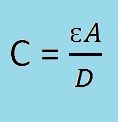
Here, C is the capacitance, ɛ is the dielectric constant of the medium and D is the distance between the plates of the capacitor.
Significance of Capacitor and its types
A capacitor is a significant electronic component of a circuit. It is needed to give electrical energy to the circuit when the power is turned off. Thus, during the on duration of battery, the capacitor gets charged to its peak value and after switching off of battery it supplies power by discharging.
It is very crucial to classify capacitors because if you need a charge storage device for power correction or in amplifiers you need a capacitor of a large capacitance. But in case of tuning circuit, you will require a small capacitance capacitor.
Thus, the different application requires a different type of capacitors. Therefore, we need to understand each type of capacitor in detail.The capacitors are broadly classified in two types, that is fixed capacitors and variable capacitors.
Fixed Capacitors
The Fixed Capacitors are those which possess a fixed value of capacitance. The value of the capacitance of fixed capacitors cannot be manipulated.
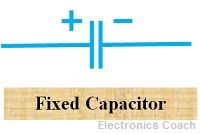
The fixed capacitors can be classified into its sub-types that are Polarized Capacitors and Non-Polarized Capacitors.
Polarized Capacitors
The Polarized Capacitors are the type of capacitor which has implicit polarity in it. The polarized Capacitor can be connected only in one way in the circuit. Polarized Capacitors possess high capacitance but it also creates a leakage current in the circuit. If the polarized capacitor is bound in a small package, it will provide small leakage current and high capacitance.
The electrolytic capacitors and the super capacitors are the sub-types of the polarized capacitor. Let’s discuss each of these types in detail.
Electrolytic Capacitors
Th electrolytic capacitors are those in which electrolyte serves as a dielectric substance. It is made up of aluminium and tantalum. The reason of using these materials is that these materials form oxides which possess extremely high dielectric strength. Thus, two aluminium foils are taken, in one of the foil the layer of oxide is formed by process of “Forming”.
In this process of “Forming,” the oxide layer is grown on it by applying voltage on the foil. The other foil provides negative connection to the capacitor. The electrolyte is soaked in a piece of paper. This serves as dielectric to the capacitor.
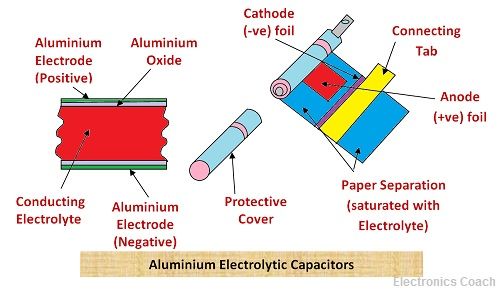
The electrolytic capacitors are of various types such as aluminium electrolytic capacitors, tantalum electrolytic capacitors and niobium capacitor depending on the type of material used. The electrolytic capacitors are available in the range from 1?F to 500,000 ?F.
Super Capacitors
Super capacitors use electrostatic double layer capacitance in place of the electrolyte. It also uses electrochemical pseudocapacitance, this helps to achieve large capacitance. While electrolyte forms a capacitor of low capacitance. The drawback of using super capacitor is that it has lower voltage limits.
Super Capacitors generally find application in cranes and elevators. The capacity of super capacitors is 10,000 times higher in comparison to that of electrolytic capacitors.
Non-Polarized Capacitors
Non-Polarized Capacitors are those which do not have implicit polarity in it, thus, they can be connected in either way in the circuit. Some of the nonpolarized capacitors are Ceramic Capacitors, Mica Capacitor, Paper Capacitor and Plastic Film Capacitors. Let’s discuss each of these in detail.
Ceramic Capacitors
The Ceramic Capacitors are made up of disc or plate which is coated with a metal such as silver or copper, on both the sides of plate or disc. The leads are made up of tin. The entire capacitor structure is packed into a plastic casing to prevent it from external environmental conditions.
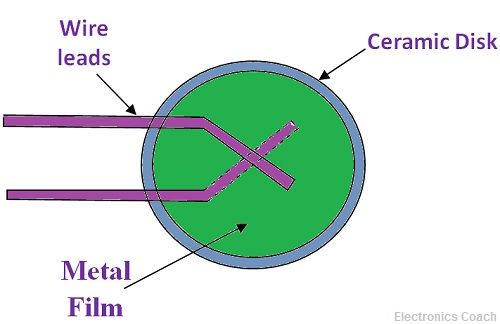
The Ceramic Capacitors can be divided into low dielectric constant type and high dielectric constant type. The low dielectric constant type results in low losses. But the low losses type ceramic capacitors offers high leakage resistance about 1000 MΩ.
The property of high-dielectric-constant of ceramic capacitors makes it capable to provide high capacitance and that too in a small volume. The value of capacitance of ceramic capacitors is dependant on various parameters such as temperature, dc voltage, frequency. Therefore, the capacitance varies if any of these parameters varies. The range of capacitance varies from 100 pF to 0.1?F.
They are classified into Class 1 Ceramic Capacitors and Class 2 Ceramic Capacitors.
Class 1 Ceramic Capacitors: These are the capacitors which possess high stability and low losses.
Class 2 Ceramic Capacitors: These are the capacitors which possess high volumetric efficiency for bypass and coupling applications.
Paper Capacitors
The paper capacitors are cylindrical shape capacitors made by rolling sheets of metal sandwiched together. The paper sheets are rolled into a cylindrical shape to form a tube structure. The complete tube structure is enclosed in the wax or plastic case. The substance such as oil, plastic or wax is used extensively for the purpose of the soaking paper.

The paper capacitors are available commercially in the range of 500 pF to 50 ?F. The paper capacitors offer high leakage current.
Mica Capacitors
The Mica capacitor is formed by sandwiching the layer of Mica between the layers of Metal. The complete structure is then enclosed a plastic package.
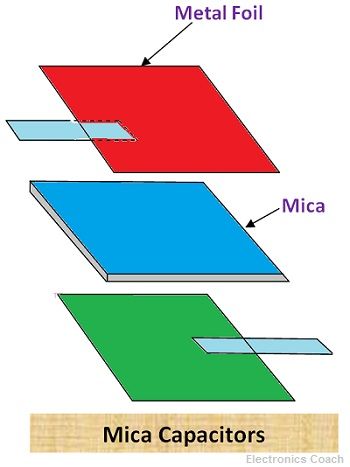
These types of capacitors possess very small leakage current because the leakage resistance is very high in case of Mica Capacitors. The range in which mica capacitors are available commercially varies from 1 pF to 0.1 pF.
Plastic-Film Capacitors
Plastic-Film Capacitors are constructed in the same way to that of the paper capacitor. The only difference is that the paper capacitors use sheets of plastic material such as Teflon, polyethene etc. as the dielectric substance. The range of capacitance of paper capacitors is from 500 pF to 10 pF.
Variable Capacitors
The capacitor in which the value of capacitance can be manipulated is called variable capacitor.
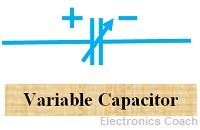
With the help of L-C Circuit, the capacitance can be tuned to the desired value.
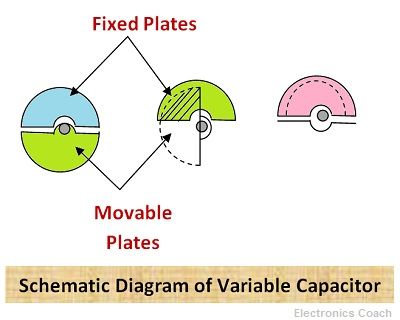
The variable capacitor can be further classified into three types that are trimming capacitors, tuning capacitors and dielectric capacitors.
Colour Coding of Capacitors
The colour coding process of capacitors can be understood with the help of below table.
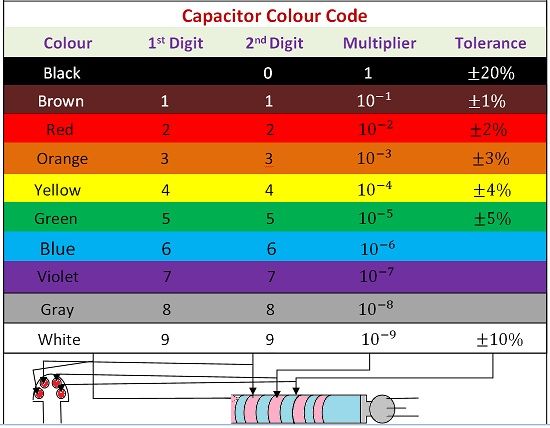
The colour coding of the capacitors is very simple to understand. With the help of this table, we can easily determine the value of any given capacitor by identifying the colour bands on it.
Leave a Reply